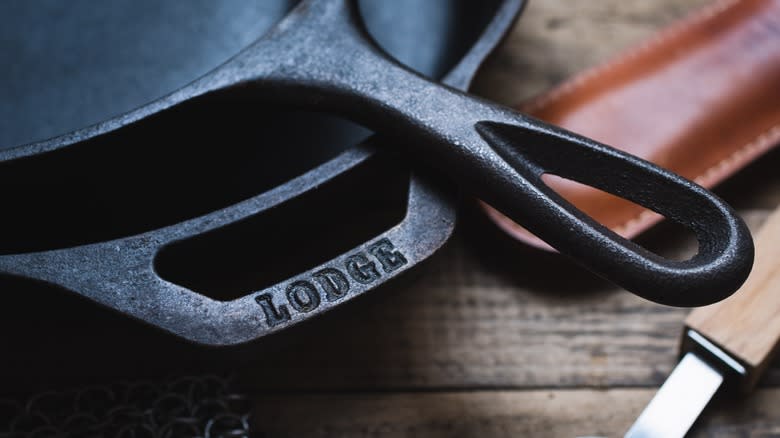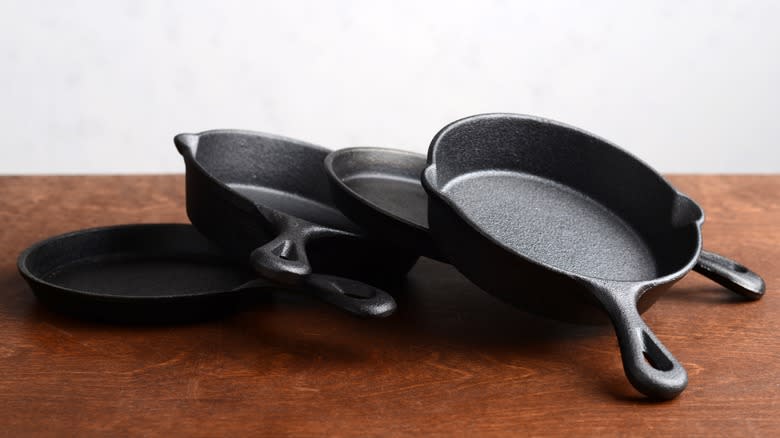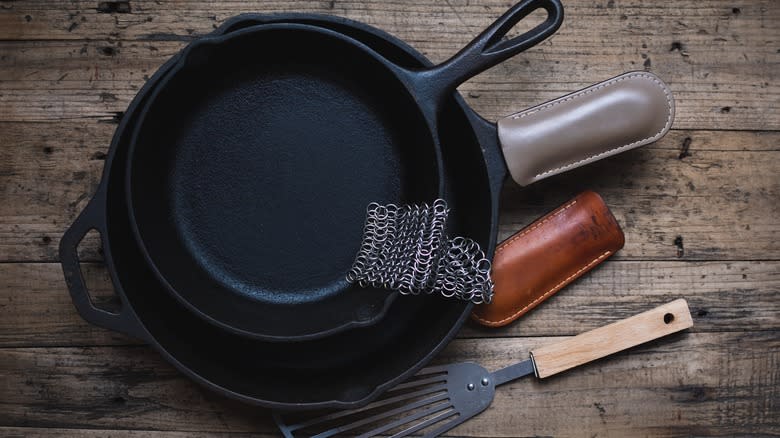Why Lodge Cast Iron Wasn't Originally Sold Pre-Seasoned

An essential rule when working with cast-iron cookware is seasoning every new piece of equipment. The process involves coating its interior with oil that has a high smoke point, then heating it to form a protective layer against rust. This helps the material become non-stick and avoid imparting a metallic taste and color to food. Seasoning is also crucial for longevity. For convenience, and because seasoning can be intimidating to first-time users, many manufacturers now sell pre-seasoned cast-iron products. But while the cast-iron cookware industry in the U.S. has been around since the late 19th century, it might be surprising to learn that the American legacy brand Lodge Manufacturing, established in 1896, only began selling pre-seasoned products in 2002.
"Everyone that owned cast iron had their own way of seasoning it," CEO and President Henry Lodge explained on the company's website in 2017. Since cooking with fat makes cast-iron pans more non-stick over time, some people would put their new cookware to use right away, cooking food slowly over low heat and with more than the usual amount of oil. In the past, people had more time to dedicate to slow-and-low cooking to season cast-iron cookware themselves. For the benefit of those who had never used — much less seasoned — cast-iron pans before, the products came with instructions on their labels, and the brand still has a seasoning guide on its website.
Read more: 15 Best Knife Brands, Ranked
Modern Manufacturing Processes Yield Rough Cast-Iron Pans

Prior to manufacturing pre-seasoned cookware, Lodge dipped its pans in hot carnauba bean wax before suspending and leaving them to dry to develop a thin, protective layer against rust during storage. Customers needed to wash off this water-soluble wax first before seasoning their new cookware themselves.
Lodge wasn't unique in selling non-seasoned pans. According to Dennis Powell, who himself founded the cast-iron cookware company Butter Pat Industries, "Up until the '50s, every cast-iron pan ever sold in America was created without pre-seasoning," (via Food & Wine). Manufacturers used to produce cookware by hand-pouring the melted combination of iron and scrap steel into molds made out of sand and letting them sit for more than 48 hours. The cast iron was then milled and polished for 24 hours to have a smooth, satiny texture before the product was sold in stores. The whole process took a minimum of three days.
However, by the mid-1900s, most companies had switched to a quicker, more mechanized method that can produce a pan in 90 minutes. It no longer includes smoothing the pots to remove embedded sand particles, which is why most products you'll find today have a rougher surface compared to vintage ones. With the lengthy polishing process eliminated, it became easier to pre-season the cookware right after production. Aside from the new method's efficiency, some manufacturers also believe that keeping cast-iron cookware rough makes it easier for the oil to adhere to the pan during seasoning.
Selling Pre-Seasoned Cookware Revitalized Lodge's Standing In The Industry

Lodge was part of the movement toward automated manufacturing. In 1950, it mechanized its foundry's molding process, followed by the automation of its casting process in 1965. But even with its improved capabilities, the brand resisted integrating a seasoning step into its production for decades.
The widespread market change and increasing consumer demand proved hard to ignore forever. With the company receiving increasing calls from customers asking how they should season their new Lodge cookware, the company began incorporating a seasoning process right in its foundry: As the pans hang on hooks, they are spray-coated with soy-based vegetable oil, then baked in extreme heat. Afterward, the pans are placed inside a rotating drum containing pieces of iron that would scrub off excess sand from their surfaces but not smoothen them.
According to Henry Lodge, the company believed that changing the manufacturing process to include a seasoning step would boost sales. Sure enough, the move further raised Lodge's profile, especially in the cast-iron cookware industry. Its ready-to-use pre-seasoned pans became a kitchen staple for both home cooks and chefs alike, earning it a wider consumer base. That includes Ina Garten, who can't go without her Lodge cast-iron skillets.
Read the original article on Tasting Table

